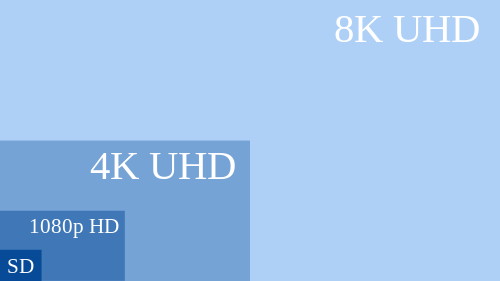< Back to all posts
How Ultra HD Will Future Proof Your Business
Over the last couple of years the buzzword has been 3D production. This year, the hype is all about 4K production.
Unlike 3D, 4K production actually stands a chance at becoming a broadcast standard. What it always comes down to is the public demand for content in that format, but consumers generally do not buy into new technology until there is an abundance of affordable content.
It’s actually other industries such as corporate media, business videos, documentaries, and smaller niche groups that are the driving force of new technology. Every industry felt the effect when the video industry made the shift from Standard Definition to High Definition. Some still have not recovered from that transition and they promised themselves they would not be caught off guard like that again when the industry made its next shift.
Put your money where your mouth is and future proof your media!
Future Proofing is about understanding which direction the video industry is going and staying ahead of the curve. If you can think back and remember the transition from standard definition to high definition — it was a mess.
In the beginning, the HD production technology was not cheap and consistently creating new formats, businesses were not convinced that their media (commercials, marketing material, promotional content, etc…) would soon be outdated and unpleasing to the eye.
| Example of High Definition (HD) Signal vs. Standard Definition (SD) Signal
|
|

|

|
| HD Signal (1080i)
|
SD Signal (480i)
|
| Source: Samsung
|
|
4K format has been standardized
The Consumer Electronics Association announced on October 17, 2012, that ‘Ultra High-Definition’, or ‘Ultra HD’, would be used for displays that have an aspect ratio of at least 16 × 9 and at least one digital input capable of carrying and presenting native video at a minimum resolution of 3,840 × 2,160 pixels.
- 4K UHDTV (2160p) has a resolution of 3840 × 2160 (8.3 megapixels), 4 times the pixels of 1080p.
- 8K UHDTV (4320p) has a resolution of 7680 × 4320 (33.2 megapixels), 16 times the pixels of current 1080p HDTV, which brings it to roughly the detail level of 15/70mm IMAX. NHK advocates the 8K UHDTV format with 22.2 surround sound as Super Hi-Vision.

Ultra High Definition Television is going to happen
The technology to supply affordable UHD Television displays is getting cheaper by the minute, which is the first indicator. The technology for creating UHD video content is still cheaper than creating content on 35mm film, but not as close to creating HD video.
Who will buy into the technology first?
Well, if we take a look at who bought into the HD technology first we see corporate media, insurance agencies, advertising firms, and documentarians making the switch first. If your company participates in shows, summits, or conventions, then you are a candidate for digital display marketing.
If you want to prolong the life of your media you must consider making the switch to Ultra High Definition production. There are a plethora of cameras already on the market that are capable of capturing UHD video.
UHD Cameras on the market:
Expect to see every one of these manufacturers begin expanding their line of Ultra HD products. In fact, Crews Control represents multiple Directors of Photography that will be early adopters of this cutting edge technology.
Why do you need to start shooting 4K video?
Obviously, you are not going to be shooting all of your content in UHD because we are not quite there yet. However, there are a few examples I can think of that would merit UHD consideration.
Anniversary Videos: Not wedding anniversaries, but company anniversaries. These are usually monumental events that businesses want documented for interior marketing, but they are so few and far between that you want them to outlast the technology of their time.
Retirement Videos: This goes along with the anniversary example, but when a CEO leaves a company is not something that generally happens often and those events are few and far between.
Corporate Meetings: If you are like most corporations, you have yearly board meetings that are heavily documented and archived. Save yourself time and money by recording these in UHD now.
Stock Footage: If you are documenting the construction of your new headquarters or anything ground breaking that has to last the test of time.
B-Roll: This is not always the first example people think of but you will thank yourself years from now when you are still able to source your material from 2013 in 2018.
Plus: Any information about a company (or corporation) that you would find in the “About Us” section of a website—and any projects that are important to a corporation’s identity that will need to be used five+ years from now.
Not convinced?
I know what you are thinking, “We heard all this last year when they tried to sell us on 3D technology.” However, I don’t think you can compare the trend with 3D to the trend that is about to happen with 4K. When HD technology was first introduced there was only one channel (I think it was even called The HDTV Channel) and soon Sports Entertainment followed by providing HD channels of their sports broadcasts.
Then it became almost a standard for all broadcast channels to provide a second channel of their content in an HD format. Now, today we have 900-something channels. Well, that didn’t happen to 3D! 3D never got its own channel nor did any industry except the film industry adopt the 3D technology.
Now that you see the pattern you should know that on January 14, 2013 Eutelsat, a French-based satellite provider, has just begun broadcasting in 4K on a demo channel. The world first 4K TV channel is now live in Europe. So now that UHD has a channel it’s only a matter of time before it becomes an industry standard.
If your camera crew has an opinion on this subject you would like to share, feel free to leave a comment and start the discussion.







Leave a Reply